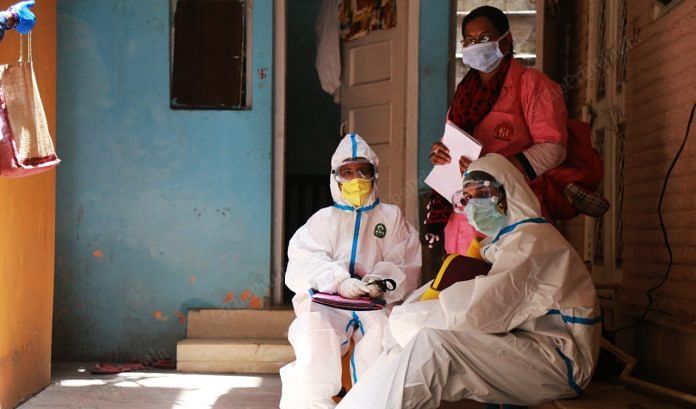New Delhi: The proportion of Delhi residents, who had Covid-19 infection until 19 June, varies from 12.95 per cent in the south-west district to 27.86 per cent in the central district — with the overall positivity standing at 23.48 per cent, according to a serological survey conducted by the National Centre for Disease Control (NCDC).
This means that for a city with a population of 2 crore, the total infection that happened until the first week of June stands at over 40 lakh — 46,96,000 to be precise.
However, this also means that Delhi’s infection fatality rate — which is the number of deaths because of Covid-19 from among people who had the infection (and were not diagnosed at the time) — stands at a miniscule 0.07 per cent.
Case fatality rate, which is the metric used more often, is the proportion of people dying out of the total number diagnosed. That number stands at 2.96 per cent.
The district-wise survey results show an infection prevalence of 22.12 per cent in southeast Delhi, 27.61 per cent in Shahdara, 23.31 per cent in north west, 22.87 per cent in New Delhi, 27.86 per cent in central Delhi, 12.95 per cent in southwest Delhi, 27.7 per cent in northeast Delhi, 23.9 per cent in east Delhi, 25.26 per cent in north Delhi, 18.61 per cent in south Delhi and 19.13 per cent in west Delhi.
A total of 21,387 samples collected across 11 districts of Delhi had antibodies against the infection. The samples were taken from people across all age groups except infants aged less than a year.
Dr Sujeet K. Singh, NCDC director, said: “Eight Delhi districts have a more than 20 per cent prevalence of infection. After nearly six months into the epidemic, only 22.86 per cent of the people are affected. This can be attributed to the efforts taken up for preventing the spread of infection through lockdown and other containment measures.”
“However, the remaining 77 per cent are still vulnerable and the containment measures need to continue with the same rigour. Non-pharmacological interventions such as physical distancing, use of face mask/cover, hand hygiene, cough etiquette must be followed strictly,” he said at a press conference.
Also read: Covid exposed global fragility. We need a new social contract: UN Chief
‘No community transmission’
The government once more reiterated that there has been no community transmission of the infection.
“The WHO does not define community transmission. It gives its member states room to define the stage of transmission. However, it is normally defined as a stage when it is impossible to trace the chain of transmission, impossible to tell who gave the infection to whom. When just 20 per cent of the population is affected, one cannot say there is community transmission,” said Rajesh Bhushan, OSD in the ministry of health.
“However, there are some clusters of Covid-19 cases and pockets of localised transmission. But we still stand by what we earlier said about community transmission,” he added.
The government’s statement comes days after Kerala Chief Minister Pinarayi Vijayan said community transmission is happening in two places in Thiruvananthapuram and West Bengal imposed a 2-day lockdown every week stating that community spread has been recorded in a few areas.
45 lakh cases may have been ‘missed’
Delhi’s serological survey figures also show that an estimated 45 lakh cases may have been missed in the national capital. It is difficult to trace the chain of transmission in infections whose very existence is unknown.
Dr Singh said that the cases may have been missed because they were asymptomatic or pre-symptomatic. Bhushan said that Delhi has increased testing hugely between June and now, and also brought down the positivity rate.
Asked about whether Delhi is past its peak, Dr Singh said with 77 per cent of the population still vulnerable and the behaviour of the virus still largely unknown, it may be difficult to say so even if cases are beginning to come down in the capital.
He also said that while there has so far been no instance of re-infection, it is difficult to make an assessment about whether the presence of antibodies provides long term protection from the infection.
Also read: In fight against coronavirus, India has age on its side. Numbers show
On vaccines
NITI Aayog member Dr V.K. Paul said the world is currently looking to be at a very good place in terms of vaccines with positive results about the immunogenicity of the Oxford University vaccine having just come in.
Asked if the government would expedite the process of regulatory clearance for the vaccine in India, Dr Paul replied in the affirmative. In India, Serum Institute will be manufacturing the vaccine and doing the trials.
“Regulatory facilitation be provided for all vaccines. We will provide all possible support. The question of supporting with resources will also be considered,” he said in answer to a query about support from the PM CARES Fund or similar such fund.
There are also two indigenous vaccines, which are in phase I and II trials, Paul said.
Also read: All focus on Covid ignores India’s silent epidemic — malnutrition. Our children are at risk



